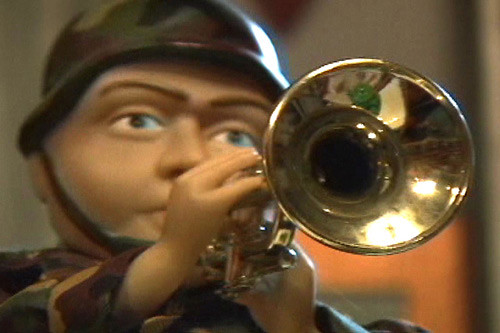Apocalypse Now
30 Nov 2007 - 26 Jan 2008

The Theater of War
30 Nov - 26 Jan 2008
Some day this war's gonna end.
—Lieutenant Colonel William Kilgore, Apocalypse Now
An attack curated by Jennifer Allora, Guillermo Calzadilla, and Jens Hoffmann
Artists include:
Antonin Artaud
Max Beckmann
Margaret Bourke-White
Mathew Brady
Jacques Callot
Bruce Conner
Leonardo da Vinci
Otto Dix
Ernst Friedrich
Francisco de Goya
George Grosz
John Heartfield
Ernst Jünger
Jon Kessler
Käthe Kollwitz
Lewis Milestone
Bruce Nauman
Pino Pascali
Pablo Picasso
Alain Resnais
Alexander Rodchenko
Martha Rosler
Luigi Russolo
Kurt Schwitters
Richard Serra
Mark Twain
With artifacts, records, films, artworks, and reproductions documenting, remembering, and presenting wars both historical and contemporary
Apocalypse Now: The Theater of War examines the philosophical terrain of war. Featuring images and sounds related to war and the impact war has on the human mind, the exhibition is more than a simple illustration of war. Instead it describes war as a universal idea of human antagonism, a set of languages and iconographies embedded in our everyday lives and broader social consciousness. Beyond an actual, specific conflict, it confronts its audience with the unpalatable side of humanity, the scenes and situations that resist engagement.
Apocalypse Now includes works by artists both historical and contemporary as well as a diverse range of cultural artifacts. Many of the pieces are deliberately conceived to block, resist, and repel the visitor, utilizing strategies of disruption, violence, and shock to function almost as weapons of attack. In addressing the connection between art and war, the exhibition looks at the aestheticization of horror, art that glorifies war versus art of protest, and the historical uses and abuses of imagery.
The show also rejects the ordinary "rules of engagement" of exhibition making in which the audience is seduced by the artworks and gently guided through the galleries. Instead, the gallery environment is inspired by bunker architecture and camouflage. The works are installed so that they wage war not only on the visitor, but also on one another. Struggle, conflict, and resistance are built into each element of the exhibition to test the audience's visual and personal boundaries.
Apocalypse Now takes its inspiration from the central position San Francisco and the Bay Area have occupied in the history of the American antiwar movement, particularly during the 1960s and 1970s, and it is intended as a revival of that pacifist tradition. It takes its title from Francis Ford Coppola's antiwar epic of the same name and references numerous aspects of the film, including its overarching framework as a journey through some of the horrors, brutalities, and irrationalities of war. Also like the film it aims to create an assault on the audience, and through that attack to elicit a powerful reaction to war's monstrosity.
Lead sponsorship for Apocalypse Now: The Theater of War is provided by the American Center Foundation.
Apocalypse Now is presented concurrently with Jennifer Allora and Guillermo Calzadilla's solo exhibition Sediments, Sentiments (Figures of Speech) at the San Francisco Art Institute, Walter and McBean Galleries, on view October 19–December 15, 2007.
Dedicated to the memory of Ernst Friedrich
www.wattis.org
